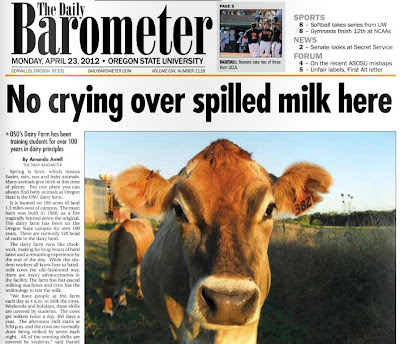PHOTO: Oregon State University's "Moo U" reputation is confirmed by the a student newspaper front-page story by Amanda Antell, "No crying over spilled milk here, OSU's Dairy Farm has been training students for over 100 years in dairy principles," Oregon State University Barometer, April 23, 2012, p. 1, 3 (with correction made April 24).
I refer to the actual cows seen on campus in the history I wrote to describe student life at Oregon State University. Cows, at least for now, have no direct link to gay activism history at OSU, but cows do fit in with the long agricultural history of OSU, which was formerly named the Oregon Agricultural College, and the conservative rural students OSU has historically attracted compared to more liberal city students who choose other state colleges. (See Thomas Kraemer, "Corvallis, Oregon State University gay activism 1969-2004," outhistory.org)
Speaking of loosely related topics (supposedly a sign of schizophrenia) it appears that Oregon State University also ranks well in the return-on-investment for students who pay for a college degree at OSU. This fits the types of majors that I mentioned in my history, such as engineering majors who often paid well after graduation. (see "Special Report: College Investment: Does It Pay? College costs are up, graduate pay is down, and 40 percent of students never get a degree. For many, return on investment is a cruel joke," BusinessWeek, April 23-29, 2012, p. 51 and see more accessed online Apr. 25, 2012, at www.businessweek.com/collegeroi) -- See businessweek.com interactive table Page 18 of 25 for the 2012 ranking of Oregon State University Public (In-State) Rank 229 out of 1248
Also note that there is a separate listing for Oregon State University Public (Out-Of-State), Rank 267 out of 1248, because tuition costs much more for out-of-state students, which makes their ROI much less. Of course, either ranks is very respectable, but I bet OSU is skewed high by the fact that OSU has many science and engineering students whose degrees command much higher salaries than your typical philosophy major. (Please accept my apology, but I couldn't resist making another loosely connected reference to the OSU gay frat boy philosophy major who was just elected to be student body vice president after coming out on the front-page of the student newspaper. See Don Iler, "From the closet to candidate, A vice presidential candidate’s journey in coming to terms with himself, his sexuality," Barometer, Apr. 27, 2012, p. 1, 3 and Don Iler, "Harris, Cushing win ASOSU presidential elections," Barometer, Apr. 30, 2012, p. 1)
The data also shows that OSU has the following statistics:
- Graduation rate 60 percent
- Undergraduates receiving grant Aid 57%
- Average Grant aid $5713
- Net Cost to Graduate $59,510
- 30-Year Net ROI including aid 294,900
- 30-Year Net ROI including aid for graduates only 491,500
- Annualized ROI 10.2
The footnote says, "The ranking was prepared by PayScale and is based on self-reported pay data obtained through its online salary survey tools; on average, pay reports from about 1,000 alumni from each school were used in the return on investment (ROI) calculations. The schools are ranked according to the 30-Year Net ROI, which represents the typical earnings of a graduate (in excess of those of a high school graduate) in 2012 dollars after deducting the net cost of the degree and adjusting for the school's six-year graduation rate. (An unadjusted ROI for graduates only is also shown.) The net cost of the degree is based on the total cost of attending the institution (including tuition & fees, room & board, and books), minus the average grant aid award, and the percentage of students who graduate in 4, 5, and 6 years. Annualized ROI is the percentage of ROI received each year after graduation; it is based on the 30-year net ROI, net cost of the degree, and annual wage inflation of 3.8 percent. Data: PayScale, Integrated Postsecondary Education Data System"
